




The Rockox House is a former residence of the Rockox family and now a museum owned by KBC Bank in the city of Antwerp, Belgium.





The Rockox House is a former residence of the Rockox family and now a museum owned by KBC Bank in the city of Antwerp, Belgium.
The house was rebuilt for Nicolaas II Rockox, lord Mayor of Antwerp. He had different houses united in 1603, and restored in Renaissance style. [1] It was his principal residence which he used for business and it was built in baroque style. A few of Rubens' most famous artworks were specially designed for this residence, among them Samson and Delilah .
The Rockox family sold the estate in 1715 to benefit the poor: the house became property of the KBC Bank, in 1970 and it is used as a public museum.
The house is a typical example of the architecture that was popular with the bourgeoisie of the early 17th century in Antwerp. It has an inner garden with fine herbs, and has features of an Italian pallazo.
The current rooms are ornated with the Old Master collection of KBC Bank. This collection is put permanently on display, like the paintings would be presented in the 17th century. However, this collection is not the historic collection as owned by the Rockox family. Besides paintings the current KBC collection includes important engravings, sculptures and textiles.
Artists whose works are on display include Jan Fyt, Cornelis Massijs, Peter Paul Rubens, Jan Sanders van Hemessen, Hans III Jordaens, Jacob Jordaens, Maerten de Vos, David Teniers, Quentin Matsys, Joachim Patinir, Frans Snyders, Lucas Faydherbe, Paulus Pontius and Lambert Lombard.
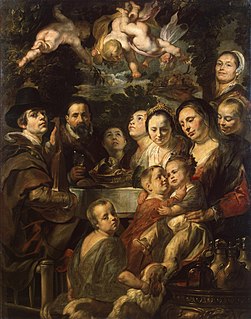
Jacob (Jacques) Jordaens was a Flemish painter, draughtsman and tapestry designer known for his history paintings, genre scenes and portraits. After Peter Paul Rubens and Anthony van Dyck, he was the leading Flemish Baroque painter of his day. Unlike those contemporaries he never travelled abroad to study Italian painting, and his career is marked by an indifference to their intellectual and courtly aspirations. In fact, except for a few short trips to locations elsewhere in the Low Countries, he remained in Antwerp his entire life. As well as being a successful painter, he was a prominent designer of tapestries.
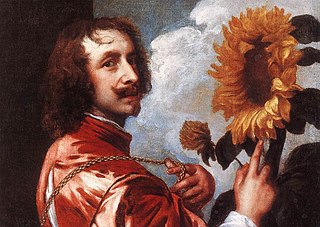
Sir Anthony van Dyck was a Flemish Baroque artist who became the leading court painter in England after success in the Southern Netherlands and Italy.

Frans Snyders or Frans Snijders was a Flemish painter of animals, hunting scenes, market scenes and still lifes. He was one of the earliest specialist animaliers and he is credited with initiating a wide variety of new still-life and animal subjects in Antwerp. He was a regular collaborator with leading Antwerp painters such as Peter Paul Rubens, Anthony van Dyck and Jacob Jordaens.

Jan Fijt or Johannes Fijt was a Flemish Baroque painter, draughtsman and etcher. One of the leading animaliers of the 17th century, he was known for his refined depictions of animals and his lush hunting pieces.

St. James' Church is a former Collegiate church in Antwerp, Belgium. The church is built on the site of a hostel for pilgrims to Santiago de Compostela. The present building is the work of the Waghemakere family and Rombout Keldermans, in Brabantine Gothic style. The church contains the grave of Peter Paul Rubens in the eastern chapel.

Cornelis de Vos was a Flemish painter, draughtsman and art dealer. He was one of the leading portrait painters in Antwerp and is best known for his sensitive portraits, in particular of children and families. He was also successful in other genres including history, religious and genre painting. He was a regular collaborator with Rubens.

The Royal Museum of Fine Arts Antwerp is a museum in Antwerp, Belgium, founded in 1810, houses a collection of paintings, sculptures and drawings from the fourteenth to the twentieth centuries. This collection is representative of the artistic production and the taste of art enthusiasts in Antwerp, Belgium and the Northern and Southern Netherlands since the 15th century. The museum has been closed for renovation since 2011.
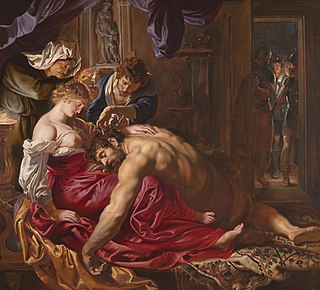
Samson and Delilah is a painting long attributed to the Flemish Baroque painter Peter Paul Rubens (1577–1640) and displayed in the National Gallery. It dates from about 1609 to 1610.
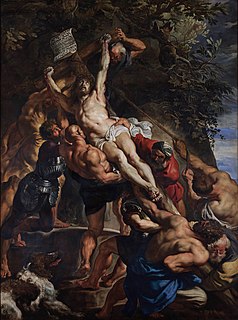
Flemish Baroque painting refers to the art produced in the Southern Netherlands during Spanish control in the 16th and 17th centuries. The period roughly begins when the Dutch Republic was split from the Habsburg Spain regions to the south with the Spanish recapturing of Antwerp in 1585 and goes until about 1700, when Spanish Habsburg authority ended with the death of King Charles II. Antwerp, home to the prominent artists Peter Paul Rubens, Anthony van Dyck, and Jacob Jordaens, was the artistic nexus, while other notable cities include Brussels and Ghent.

Jan Boeckhorst or Johann Bockhorst was a German-born Flemish Baroque painter and draughtsman. He was a versatile artist who produced history paintings, genre scenes and portraits in a style influenced by the trio of leading Baroque painters in Antwerp Peter Paul Rubens, Anthony van Dyck and Jacob Jordaens. Boeckhorst also worked as a designer of cartoons for tapestries.
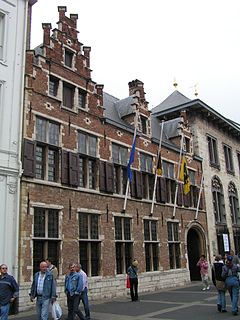
The Rubenshuis is the former home and workshop of Peter Paul Rubens (1577–1640) in Antwerp. Purchased in 1610, Rubens had the Flemish townhouse renovated and extended on the basis of designs by Rubens himself. After the renovations, the house and its courtyard garden had the outlook of an Italian palazzo, which reflected the artistic ideals of Rubens. The ensemble is now a museum dedicated mainly to the work of Rubens and his contemporaries.

Sir Peter Paul Rubens was a Flemish artist and diplomat from the Duchy of Brabant in the Southern Netherlands. He is considered the most influential artist of the Flemish Baroque tradition. Rubens's highly charged compositions reference erudite aspects of classical and Christian history. His unique and immensely popular Baroque style emphasized movement, colour, and sensuality, which followed the immediate, dramatic artistic style promoted in the Counter-Reformation. Rubens was a painter producing altarpieces, portraits, landscapes, and history paintings of mythological and allegorical subjects. He was also a prolific designer of cartoons for the Flemish tapestry workshops and of frontispieces for the publishers in Antwerp.
Rameyen Castle is a castle on a lake in Gestel, part of the municipality of Berlaar, in the province of Antwerp, Belgium. It was once owned by Nicolaas Rubens, Lord of Rameyen, who died in the castle. Nicolaas was the second son of Peter Paul Rubens.
Diego Duarte or Jacob Duarte (1612–1691) was a 17th-century Portuguese jeweler, banker, composer, organist and art collector living in Antwerp, who owned paintings by Jan Vermeer, Raphael and others.

Paulus Pontius was a Flemish engraver and painter. He was one of the leading engravers connected with the workshop of Peter Paul Rubens. After Rubens' death, Pontus worked with other leading Antwerp painters such as Anthony van Dyck and Jacob Jordaens.

The St. Paul's Church or Sint-Pauluskerk is a Roman Catholic church located at the Veemarkt in Antwerp. Its exterior is mainly Gothic with a Baroque tower while the interior is characterised by its rich Baroque decoration. It holds paintings by Antwerp's leading artists Peter Paul Rubens, Anthony van Dyck and Jacob Jordaens as well as abundant sculpture and church furniture crafted by leading Antwerp sculptors such as Artus Quellinus the Elder, Pieter Verbrugghen I, Jan Pieter van Baurscheit de Elder, Jan Claudius de Cock and Andries Colyns de Nole. Of particular note is the Calvary outside the Church which is made up of 63 life-size statues and nine reliefs executed in a popular and theatrical style.
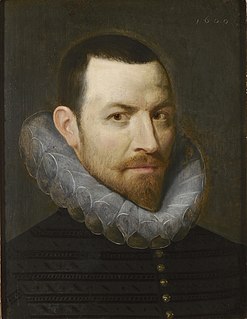
Nicolaas Rockox (1560–1640), was a mayor of Antwerp. He was a close personal friend and important patron of Peter Paul Rubens. His residence in Antwerp is now a museum known as the Rockox House. He was knighted by Archduke Albert and Isabella, the Governor General of the Southern Netherlands.

The Phoebus Foundation is an art foundation established in Jersey in 2011. It is based on Anglo-Saxon law with philanthropic objectives. The foundation acquires works of art, guarantees a professional framework of conservation and management, and looks after the conservation and restoration of the objects. In doing so, it focuses on scientific research. It shares the results of this all with the widest possible audience, through exhibitions, cultural expeditions, symposiums and publications.

The Maagdenhuis Museum is an art museum and historical museum located in a 17th-century historic building on Lange Gasthuisstraat, Antwerp, Belgium. The building was used as an orphanage for the maegdeckens, or maidens, from the mid-16th century to the end of the 19th century. The museum presents a collection of utensils used on a daily basis by the foundlings and the orphans; a collection of antique furniture, and a series of documents relating to the orphanage and the life in it from the 16th century to 19th century.

Tobias' Journey is an oil on panel painting by Flemish artist Joos de Momper. The painting showcases Momper's large scale, imaginary landscape painting and his interpretation of perspective in distant views while at the same time treating a biblical subject. The painting depicts the story of Tobit, a righteous Israelite of the tribe of Naphtali, living in Nineveh, who is sent to recover is father's money to Media, escorted by the Archangel Raphael. The painting is currently housed at the Rockox House in Antwerp.